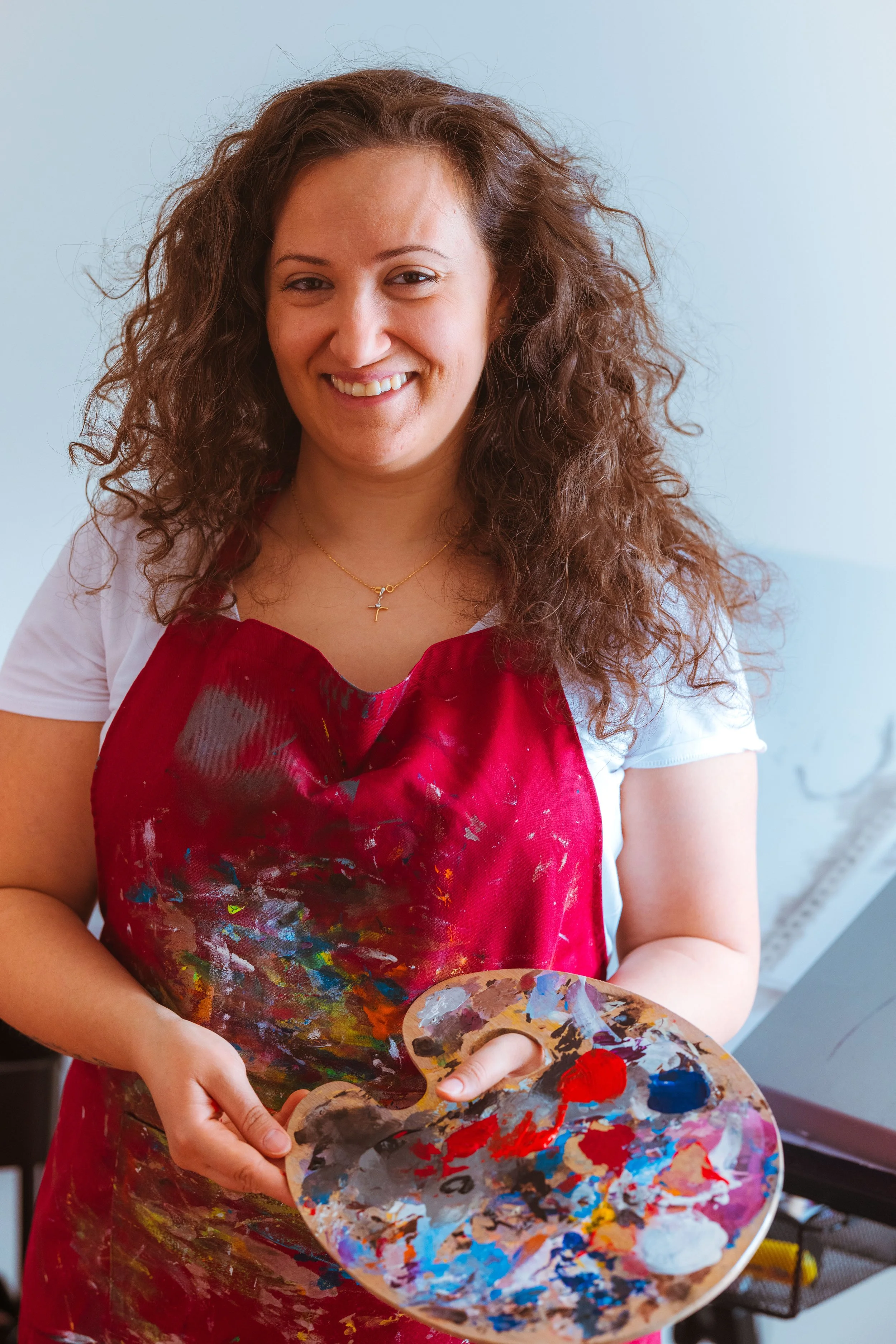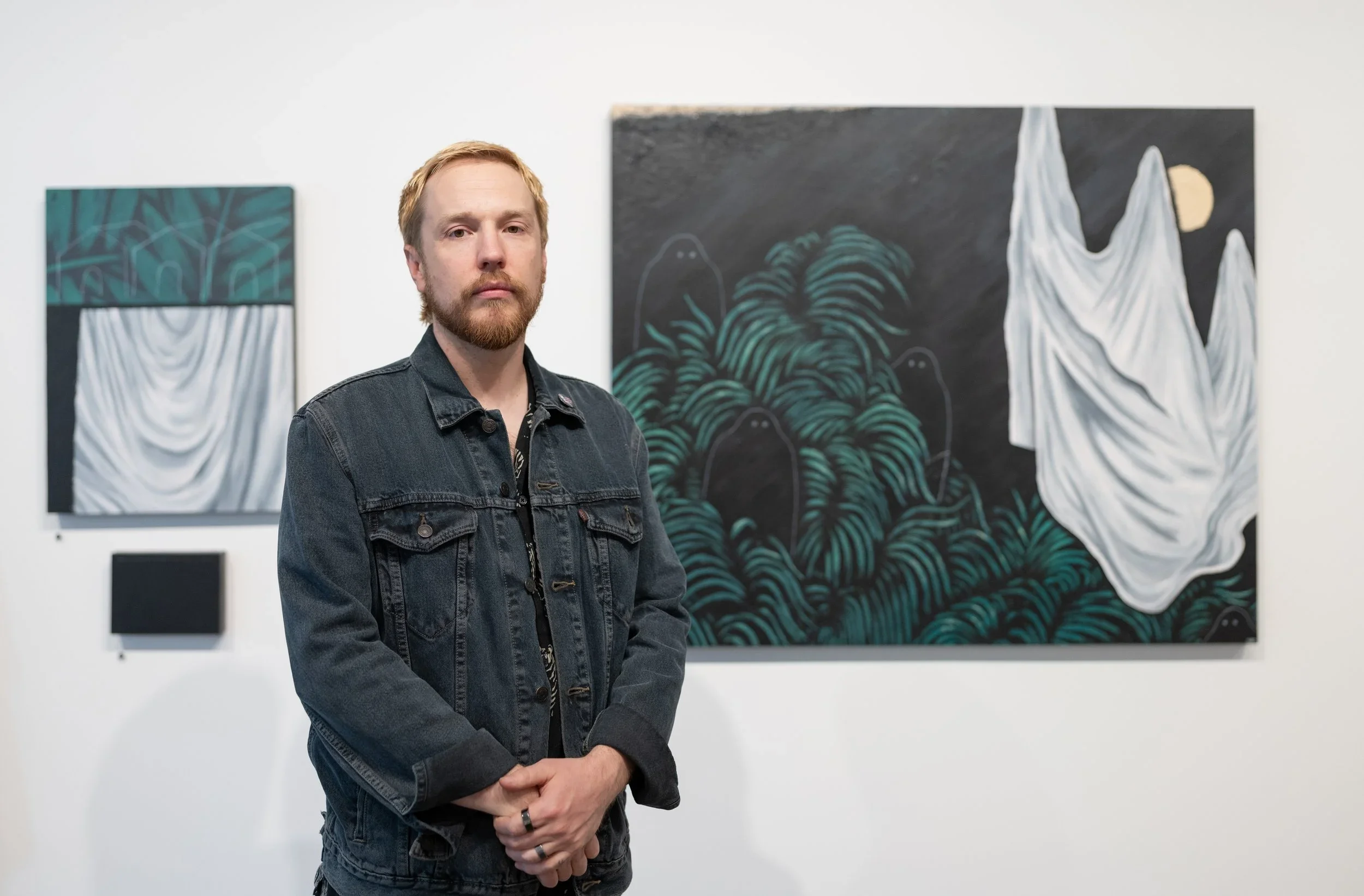10 Questions with Léa. M
Lebanese-Canadian artist Léa. M, currently based in the United Arab Emirates, brings a bold and uninhibited approach to contemporary painting.
Entirely self-taught, she draws inspiration from post-impressionist and expressionist movements, channelling their emotive power and vibrant aesthetics into a style that is uniquely her own. Her work captures fleeting moments of joy, spontaneity, and human vitality, translating emotion into colour and movement through the vigorous application of thick acrylic paint.
Léa. M - Portrait
Léa’s paintings are distinguished by their exuberant energy and emotional resonance. She focuses on portraying deeply human experiences, moments of connection, celebration, introspection, and resilience, through vivid, textured compositions. Her use of palette knives, rather than brushes, allows her to apply paint in bold, confident strokes, resulting in a richly layered surface that adds a three-dimensional, almost sculptural quality to her canvases. Each stroke is intentional, building not only form and colour but also a sense of motion and tactile presence.
What truly sets Léa. M apart is her remarkable ability to breathe life into her work. Her paintings do more than depict, they evoke. They invite viewers into an emotional dialogue, turning static images into kinetic expressions of spirit and strength. Her fearless use of colour, coupled with a deep intuitive understanding of form and texture, lends her work a signature vibrancy and immediacy.
Léa. M’s art stands as a celebration of individuality and empowerment. In an ever-changing world, her work serves as a vibrant reminder of the beauty found in the present moment and the emotional truths that connect us all. As her creative voice continues to evolve, she remains a powerful and inspiring presence within the contemporary art landscape.
Bubble, Acrylic On Canvas, 27"x40", 2018 © Léa. M
INTERVIEW
First of all, can you tell us about your journey into painting? What inspired you to pursue it without formal training?
From a young age, I was instinctively drawn to colour and form. I would sketch on any surface I could find, fill the margins of my notebooks with doodles, and sell small drawings to save for pocket money. Art felt like a natural extension of who I was. I longed to pursue it professionally, but my aspirations were redirected; at the time, a career in art was not considered a viable path. Instead, I followed a more conventional route, studying social sciences and eventually earning a master's degree.
Life unfolded, career, marriage, motherhood, and for a time, painting slipped quietly into the background. Yet, the creative urge never fully left me. In my thirties, that dormant part of me stirred again. I began painting at night, once the house had fallen silent and my children were asleep. What began as a quiet return soon reignited into a full-fledged passion, as if no time had passed at all.
With no formal training, I became a student of my own curiosity, learning through observation, studying the work of artists I admired, and immersing myself in techniques through digital platforms. Slowly, intuitively, I shaped my artistic voice, driven by a deep inner need to express and to reconnect with the part of myself that had waited patiently to reemerge.
How have post-impressionism and expressionism influenced your personal style?
The emotional intensity and raw honesty of Expressionism have profoundly shaped my artistic vision. Expressionist artists sought to externalise their inner worlds, using distorted forms, exaggerated contours, and impassioned brushwork to create a visual language that transcended realism. Post-Impressionism, with its vivid palettes, deliberate structure, and expressive use of colour and texture, offered an equally compelling foundation. The works of Vincent van Gogh, Paul Gauguin, and Edvard Munch in particular left a lasting impression on me, their ability to distil complex human emotions into pure form and colour continues to inspire my practice.
In my own work, I strive to capture the essence of emotion and character, often through the depiction of women who embody strength, vulnerability, and individuality. Each figure is an attempt to express an inner truth, a feeling, a moment, a story, conveyed through gesture, posture, and gaze. The use of thick, textured layers of paint is integral to this expression, creating a tactile surface that invites close viewing and evokes a visceral connection. Colour, for me, functions as a language of emotion, vibrant, unrestrained, and deliberate, drawing the viewer into a dialogue that goes beyond the visual, toward something deeply felt.
Next Morning, Acrylic On Canvas, 20"x16", 2021 © Léa. M
News, Acrylic On Canvas, 20"x16", 2021 © Léa. M
What emotions or moments are you most drawn to capturing in your work?
It's not just emotion I seek to convey, it's character as well. Each painting tells a story, one that evokes emotion through the presence and essence of its subject. Take, for example, the artwork Queen. She is unapologetically herself, confident, composed, and unbothered by external judgment. She knows her worth and defines her identity on her own terms. In Edna, we encounter a strikingly different energy: Edna demands attention. Her presence is commanding, her beauty and attitude impossible to ignore, she insists on being seen and acknowledged.
Then there's Rusty Ride, a piece that evokes a sense of freedom and sensuality. It invites the viewer to breathe deeply, to release, to feel. Each time you return to it, there's a renewed sense of liberation. Every painting is a synthesis of emotion and character, each one a journey into a feeling you've known or longed to experience. Whether it's the warmth of being in love, the chill of a cold day softened by a beanie, or the quiet sting of regret, as captured in The Next Morning, these works resonate because they reflect moments we've lived, or wished we had.
Why do you prefer working with palette knives instead of brushes?
Working with a palette knife introduces a distinct texture, bold, deliberate, and rich with dimension. The strokes are more defined, the blending more visible, and the colours remain raw and expressive. This technique creates a thickness and tactile quality that I'm deeply drawn to; it's something I actively seek in every painting. It engages more than just the eyes, it invites you to hear, feel, and almost taste the colours, awakening the senses in unison.
Using a palette knife feels instinctive to me. It's not only a technique, but a space of comfort, a natural extension of how I express myself on canvas.
Edna, Acrylic On Canvas, 47”x31”, 2018 © Léa. M
How does your creative process unfold when you start a new painting?
My creative process always begins with a feeling I need to express, or with a gesture, action, or individual whose distinctive character captures my attention. Sometimes it's as subtle as the way she styles her hair, or the nuance of a hand movement, small details that carry immense meaning. From there, I choose the colours, which are carefully selected to complement and deepen the narrative. In the later stages, I incorporate drips and splashes, an essential part of my work. Without them, the painting feels incomplete. Each artwork features a different rhythm and style of splashes, guided by the emotion I aim to evoke.
And finally, perhaps most importantly, comes the naming of the piece. For me, the title is not an afterthought, it is a continuation of the story, a final layer that brings the emotional arc of the artwork full circle.
Colour and texture are central to your work. How do you choose your colour palettes?
Colour and texture are inseparable elements in my creative process; they are the emotional language of my work. I don't begin with a fixed palette; instead, I let the subject and the feeling I want to convey guide my choices. Each piece begins with a mood, a memory, or a character, and the colours emerge intuitively from there. Texture, created through thick layers of paint and palette knife work, gives these colours physicality; it makes them tangible, almost sculptural.
Ultimately, I choose colours not only for their visual impact but for their ability to evoke a visceral, sensory response. I want the viewer to feel the energy, to sense the emotion embedded in each stroke, and to connect on a level beyond the visual.
Your paintings often feel full of life and movement. What do you hope viewers feel when they experience your art?
I hope viewers feel a deep sense of connection when they encounter my work, not just with the painting, but with the woman within it. Each piece is a celebration of character, not only emotion. I want people to sense the strength, confidence, vulnerability, or complexity of the women I portray, and perhaps recognise a part of themselves in that presence. The movement in my work comes through bold colours, layered textures, and expressive strokes. They bring the figures to life and create a rhythm that invites the viewer in. I hope that energy stirs something visceral, whether it's empowerment, curiosity, or simply a pause to reflect. Ultimately, I want my art to make people feel seen, moved, and inspired, to walk away with a lingering emotional resonance that stays with them long after they've looked away.
Queen, Acrylic On Canvas, 24"x30", 2022 © Léa. M
WannaB, Acrylic On Canvas, 20"x31", 2025 © Léa. M
What does empowerment mean to you, and how does it translate into your work?
Empowerment, to me, is about owning your story, unapologetically and with confidence. It's the freedom to define yourself on your own terms, to be seen and heard for who you truly are. In my work, empowerment is expressed through the women I paint. Each figure embodies a distinct presence, bold, graceful, defiant, or reflective, but always grounded in self-worth and individuality.
I use vibrant colours and rich textures not just for their visual impact, but to give weight and voice to these women. Their postures, expressions, and gestures speak volumes. They don't ask for permission to exist; they take up space, theydemand to be acknowledged.
What are you working on now? Do you have any new series or projects you are currently developing?
I'm currently challenging myself to move beyond my comfort zone and explore more abstract forms of expression. I want to break free from defined lines and structured figures, while still staying true to my signature technique—using vibrant colours, thick textures, and my trusted palette knife. The goal is to continue evoking strong emotion and presence, but in a way that feels freer, more instinctive. I'm working on creating pieces that can fill a room with energy, artworks that captivate, spark curiosity, and speak without needing to explain themselves. It's about pushing boundaries while staying rooted in what makes my art feel alive.
And lastly, how do you see your art evolving in the coming years?
As I experiment on a daily basis, I hope my work will continue to evoke the same powerful feelings, only in new, uncharted ways. I aim to create art that transforms a space, turns heads, and fills a room with energy, inviting the viewer to experience it not just visually, but emotionally. Ultimately, I see my art as a constant evolution, a journey of refining my voice while embracing new possibilities.
Artist’s Talk
Al-Tiba9 Interviews is a promotional platform for artists to articulate their vision and engage them with our diverse readership through a published art dialogue. The artists are interviewed by Mohamed Benhadj, the founder & curator of Al-Tiba9, to highlight their artistic careers and introduce them to the international contemporary art scene across our vast network of museums, galleries, art professionals, art dealers, collectors, and art lovers across the globe.





















